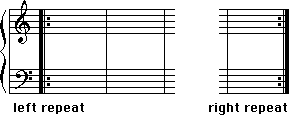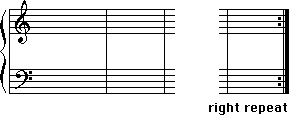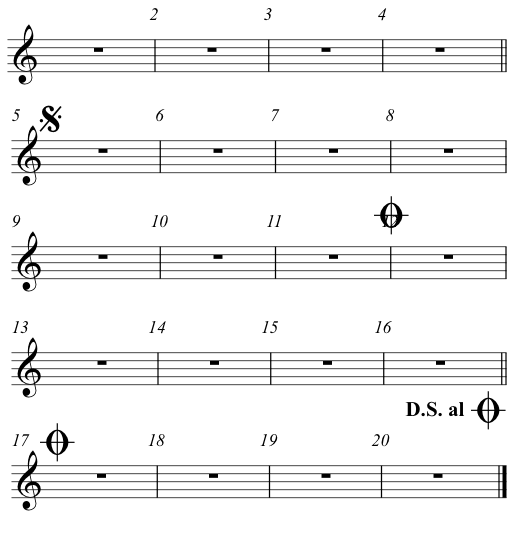Written music is organized into measures separated by barlines. There are several types of barlines. The most common barline is a single vertical line that separates the music into measures. The sum of the rhythm values of every note in the measure has to add up to the values specified by the time signature. A double barline is used to indicate large subdivisions of the musical form. The final barline is written as a thin barline followed by a thick barline and is used at the end of every piece of music.
Thick and thin barlines are also used for repeat signs. Repeat signs usually appear in pairs and look like a final barline with two dots placed in the second and third spaces. The music between the repeat signs is played twice.
The left repeat marks the beginning of the repeated section and faces right. The right repeat marks the end of the repeated section and faces left.

In the absence of a left repeat sign, the repeat goes all the way back to the beginning of the music.

Sometimes the music will indicate a first and second ending. The first ending is played the first time through the repeat. The second time through the repeat, the first ending is skipped, the second ending is played and the music continues from there.
Three notation elements appear in the first line of every piece music: the clef, the key signature, and the time signature. The clef and key signature appear at the beginning of every line of music. The time signature appears only on the first line and is not written again until it is changed.
Primary beams are unbroken and connect an entire musical unit. Secondary beams are used to subdivide the primary beam. The stem connects to the primary beam and passes through all secondary beams.
Both primary and secondary beams make clear the inner subdivisions of the beat. In this example each beamed group adds up to one quarter note, the notated beat unit.
The placement of the beam depends on whether the majority of notes in the group are above or below the middle line. If majority of notes are above the middle line the beam goes down.
If majority of notes are below the middle line the beam goes up.
If there is no majority, then beam is determined by the note at the greatest distance from middle line.
In case all notes are equidistant from the middle line, prefer stems down.
The beam direction (slant) follows the general ascending or descending direction of notes they connect.
Horizontal beams are used when beginning and ending notes of the group are same.
Primary beams may connect across beat units. The first beat subdivision can be beamed as follows.
When secondary beams are used, beams do not connect across the beat unit.
Primary beams may connect across beat units. The first beat subdivision can be beamed as follows.
When secondary beams are used, beams do not connect across the beat unit.
Primary beam groups can connect beats 1-2 or beats 3-4 but never 2-3.
In quadruple time, each half of the measure (beats 1-2 and beats 3-4) must add up to equal rhythm units. In the following example a tie needs to be used to keep each half the the measure equal to four eighth notes.

When secondary beams are used, beams do not connect across the beat unit.
The octave (8va ) sign is used to reduce the number of ledger lines and make the music easier to read. A dotted line and ending bracket extends to the right of the 8va symbol to indicate exactly which notes are affected. The term comes from the Italian phrase "all ottava" that could be translated "at the octave." When the symbol occurs above notes it indicates those notes are to be played one octave higher than written. When the symbol appears below notes it indicates those notes are to be played one octave lower than written.
Two octaves higher or lower is indicated as 15ma.
When you encounter D.C. al Fine in the music you are directed to go back to the beginning of the piece and continue playing until the word Fine appears. DC al Fine comes from the Italian phrase "Da Capo al Fine," that could be translated "the head until the end." In the following example you would play lines one through four, then go back to the beginning and play lines one and two over again, ending at Fine. Fine is pronounced "fee-nay."
When you encounter D.S. Al Fine in the music you are directed to go back to the the sign and continue playing until the word Fine appears. The fancy symbol near the beginning of line two is "the sign." D. S. al Fine comes from the Italian phrase "Dal Segno al Fine," that could be translated "the sign until the end." In the following example you would play lines one through four, then go back to the the sign at the beginning of line two, play lines two and three ending at Fine.
The Coda symbol ![]() indicates
a place in the music where you skip from one place to another.
Coda signs are often used in pairs.
indicates
a place in the music where you skip from one place to another.
Coda signs are often used in pairs.
In the following example you would play measures 1-16 where you reach the D.S. al Coda text. D.S. means go back to the sign (fancy "S") which is in measure 5 and play until you reach the first coda symbol. That means you play measures 5-11 again. When you reach the first coda symbol at the end of measure 11 you skip to the matching coda symbol in measure 17. You now play measures 17-20 and end.
Note that the sign symbol ("S") and the Coda symbol are placed above the staff. The text D.S. al Coda is placed below the staff.
This is the order you play in measure numbers: 1-16, 5-11, 17-20.

Revised by John Ellinger, Spring 2012.